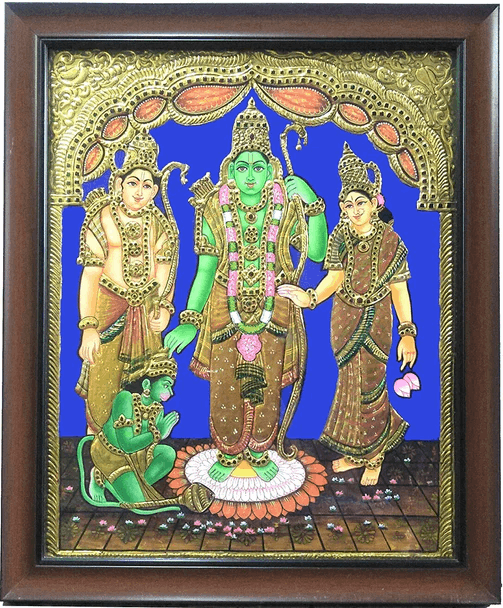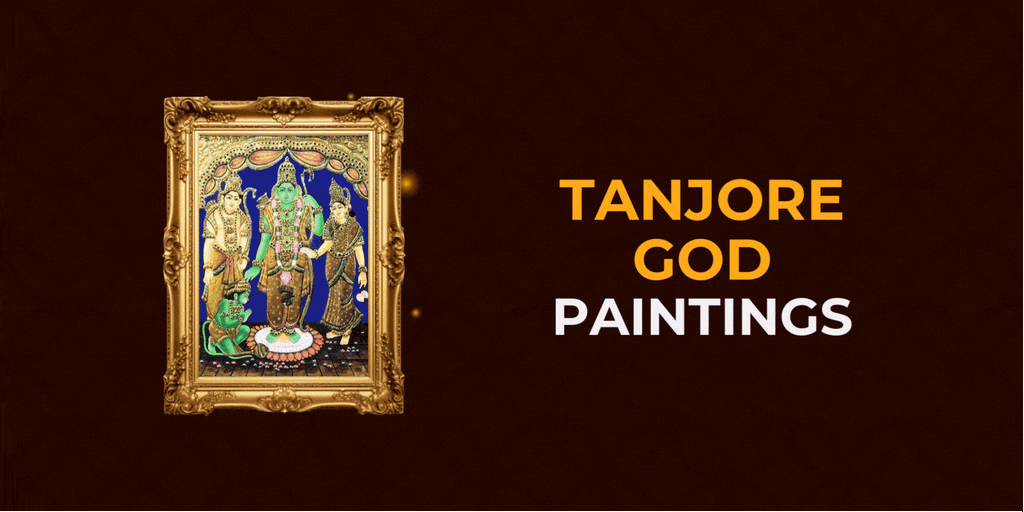Many artists feel inspired to paint Rama's coronation in Tanjore paintings. This is because it's a significant theme in Hinduism, and the people of India love the Ramayana story. Tanjore paintings have origins in Tanjore in Tamil Nadu, also called Thanjavur. They are known for being beautiful with bright colors and intricate goldwork. They show stories from ancient Hindu texts and help us understand Indian stories about Gods and Goddesses artistically.
Nowadays, you can find Tanjore paintings online. It makes it easy for people who love art to buy them. Tanjore painting prices online can vary depending on some factors. It includes how big the painting is, how well the artist has made it, how famous it is, and what materials the artist used to make it. If a Tanjore painting online is rare or has a lot of history, it costs more. Also, if lots of people like a particular artist's work, their paintings might be more expensive online.
Table of Contents
The Coronation of Rama: The Best of Tanjore God Paintings Online
Why is Rama's Coronation a Favored Subject in Tanjore God Paintings?
What are the Symbolic Elements Often Seen in Rama Pattabhishekam Tanjore Paintings?
The Coronation of Rama: The Best of Tanjore God Paintings Online
The celebration of Rama's coronation ceremony, or Rama Pattabhishekam, has a great religious and cultural impact on Hindu culture. This ceremony is the touching conclusion to an epic journey narrated in the Hindu sacred text of the Ramayana. The story starts with Ayodhya's prince, Rama, leaving for a 14-year exile to the forest. Rama does so to fulfill a pledge given to his stepmother, Kaikeyi, by his father, King Dasharatha. On this journey, Rama is not by himself. He is accompanied by his faithful brother, Lakshmana, and his loving wife, Sita.
But when the demon king Ravana finds Sita during their exile, he kidnaps her. To save his queen, Rama starts his journey to Lanka, Ravana's home. In this battle, Rama is assisted by his Lakshmana and Hanuman, the monkey fighters, and his army of Vanaras, or monkey-men. Ultimately, Rama triumphs over Ravana and saves Sita from his clutches.
Upon Rama, Sita, and Lakshmana's return to Ayodhya, the people celebrated in jubilation. They eagerly awaited their beloved prince to take his throne as the rightful king. The coronation ceremony is held in Ayodhya as a grand occasion, attended by gods, sages, and dignitaries.

Why is Rama's Coronation a Favored Subject in Tanjore God Paintings?
1. Spiritual Significance
Rama's coronation stands for the rule of dharma (righteousness) of a just and virtuous king. It shows the triumph of good over evil and the bringing forth of order and harmony in the universe. As such, these Tanjore God paintings hold a profound spiritual value for Hindus and are a source of inspiration and respect.
2. Devotional Practice
People often use Tanjore God paintings as objects of worship in Hindu households and temples. Painting with themes from Ramayana allows devotees to connect with God on a deeply spiritual level. Creating or owning a Tanjore God painting is like an expression of devotion and respect towards God for the devotees.
3. Aesthetic Appeal
Tanjore God paintings are famous for their grandeur and ornate beauty. Artists add vibrant colors, gold leaf, and beautifully colored gemstones to these paintings and create visually stunning art pieces. The coronation scene provides artists with ample opportunities to showcase their skill and creativity, resulting in breathtakingly beautiful works of art.
4. Cultural Identity
Rama's coronation is of cultural importance as it discusses traditional Indian values and ideals. It brings forth concepts of dharma, duty, honor, and sacrifice, which are highly placed in Indian society. By presenting this iconic event in Tanjore God paintings, artists pay homage to these timeless values. Indeed, Tanjore paintings celebrate India's rich cultural heritage.

What are the Symbolic Elements Often Seen in Rama Pattabhishekam Tanjore Paintings?
Paintings depicting Rama's coronation feature several symbolic elements. Each symbol in these Tanjore God paintings carries a meaning to it. Here are some key symbols to look out for:
Rama: As the central figure of the ceremony, Rama stands for righteousness, virtue, and divine kingship. He adorns the regal attire and carries a bow and an arrow. He has a serene expression and conduct, befitting a noble and just ruler.
Sita: Rama's wife, Sita, is present alongside him during the ceremony. She symbolizes purity, devotion, and the ideal of wifely virtue. Her presence shows the importance of partnership and harmony in a royal union.
Lakshmana: Rama's loyal brother, Lakshmana, is another crucial figure in such Tanjore God paintings. He symbolizes loyalty, duty, and selflessness. He served as a steadfast companion and supporter of Rama throughout his journey.
Hanuman: The monkey warrior Hanuman is a devotee of Rama. His presence at the event symbolizes devotion, courage, and unwavering loyalty. Hanuman plays a very important role in the Ramayana, particularly in rescuing Sita from Lanka.
Deities and Divine Beings: The scene may feature various gods, goddesses, and celestial beings in attendance. Deities such as Brahma, Vishnu, and Shiva witness Rama's ascension to the throne, which signifies that Lord Rama had divine sanction of his kingship.
Sacred Objects and Rituals: Tanjore Rama Pattabhishekam paintings often include objects associated with the ceremony. These may include the royal umbrella (chatra) and the ceremonial conch shell (shankha). There may also be auspicious symbols (such as the lotus and conch) and offerings of flowers, fruits, and incense. Each of these elements symbolizes auspiciousness, prosperity, and divine favor.
Decorative Motifs and Ornamentation: Tanjore paintings have ornate decorations and intricate detailing as their basic style. Look for elaborate borders, floral motifs, geometric patterns, and gold leaf details surrounding the central scene of the coronation.
These symbolic elements enhance the visual richness of the painting and contribute to its overall aesthetic appeal. Each element serves to enrich the narrative and convey the timeless ideals of righteousness, devotion, and divine kingship.
Conclusion
Rama's coronation paintings vividly show the special moment in Ramayana when Rama became the king of Ayodhya. Made in the traditional style, these Tanjore God paintings display the grandness, symbolism, and spiritual importance of Rama's coronation. They remind us of goodness, fairness, and Rama's royal status. Finding Tanjore paintings online has changed how people buy art. It's now easy for anyone who loves art to get one of their favorite paintings online. Online platforms like Mangala Tanjore Paintings have made it simple to bring the beauty and meaning of Rama's coronation into people's homes.
If you're searching for a beautiful portrayal of Rama's coronation, look no further than Mangala Tanjore paintings. Renowned for our exquisite craftsmanship and attention to detail, Mangala Tanjore paintings offer a wide selection of artworks. Each captures the grandeur and spiritual significance of this iconic event from Hindu mythology. You can revel in their rich colors, intricate designs, and impeccable quality. A painting from Mangala Tanjore is sure to become a cherished centerpiece in any collection.





